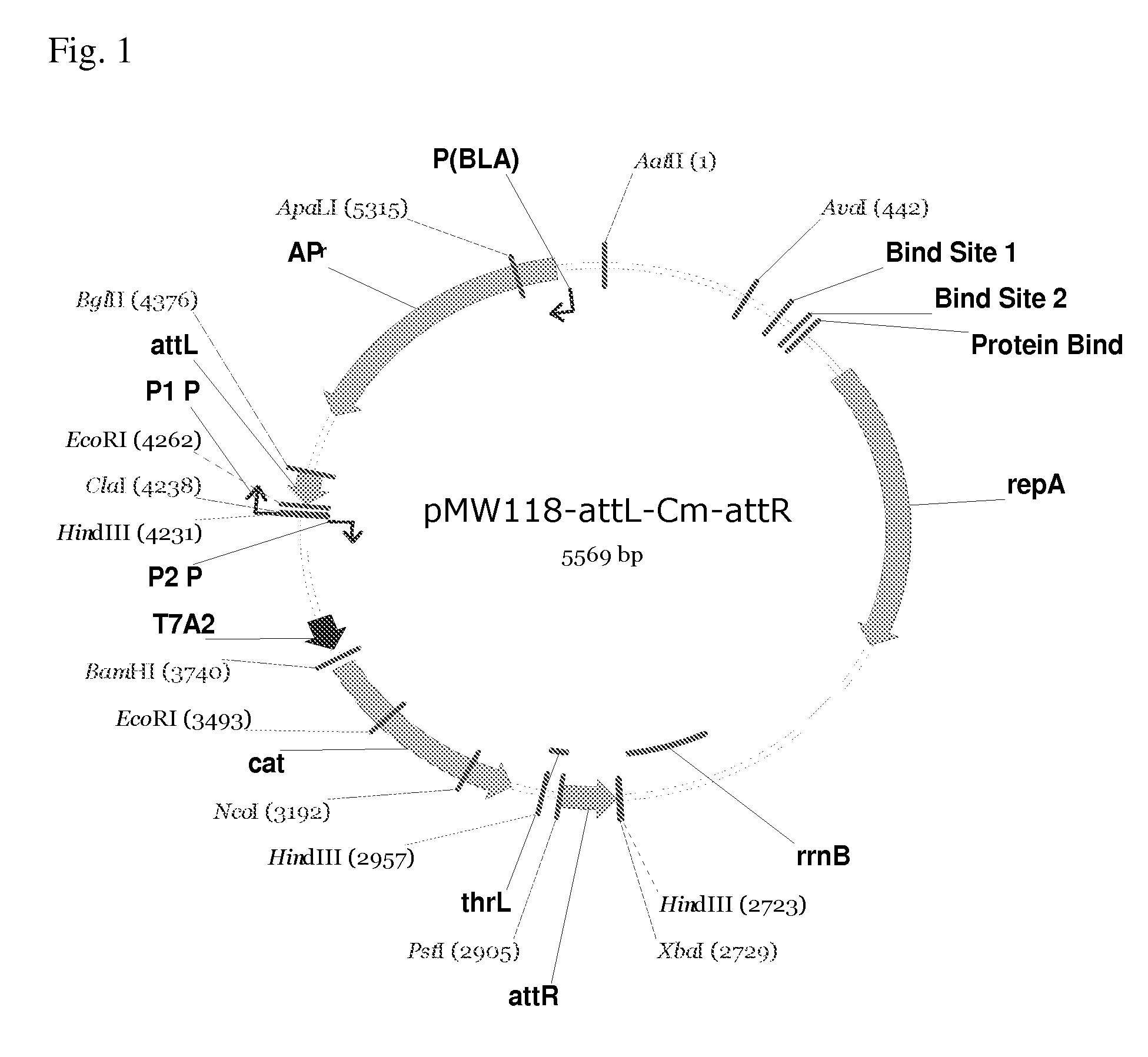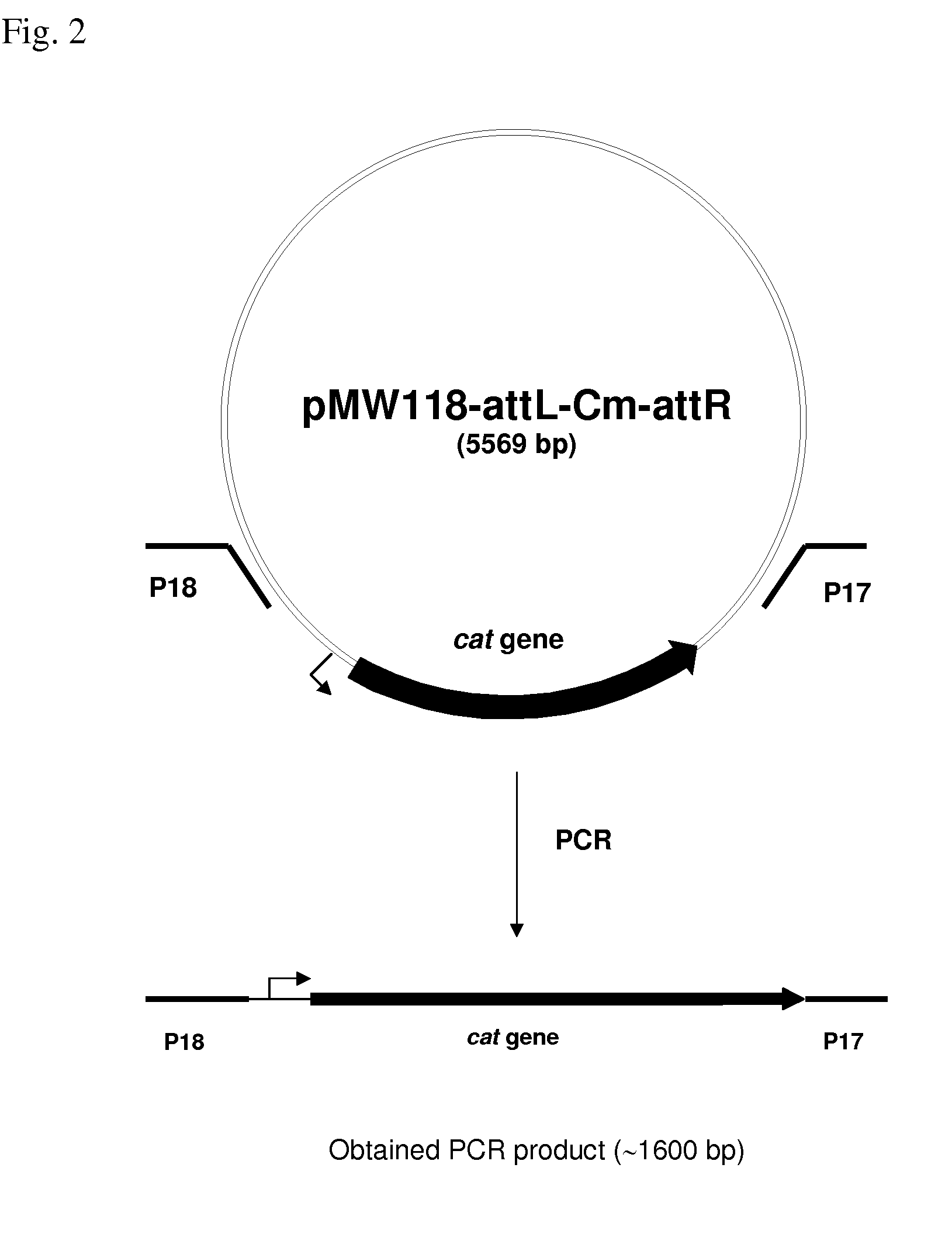Method for Producing an L-Amino Acid Using a Bacterium of the Enterobacteriaceae Family With Enhanced Expression of the fucPIKUR Operon
a technology of enterobacteriaceae and l-amino acid, which is applied in the field of microorganisms, bacteria, microorganisms, etc., can solve the problem of no reports of enhancing the expression of the fucpikur operon gene, and achieve the effect of enhancing the productivity of l-amino acid-producing strains
- Summary
- Abstract
- Description
- Claims
- Application Information
AI Technical Summary
Benefits of technology
Problems solved by technology
Method used
Image
Examples
example 1
Preparation of the PCR Template and Helper Plasmids
[0122]The PCR template plasmid pMW118-attL-Cm-attR and the helper plasmid pMW-intxis-ts were prepared as follows:
[0123](1) pMW118-attL-Cm-attR
[0124]The pMW118-attL-Cm-attR plasmid was constructed on the basis of pMW118-attL-Tc-attR that was obtained by ligation of the following four DNA fragments:[0125]1) the BglII-EcoRI fragment (114 bp) carrying attL (SEQ ID NO: 11) which was obtained by PCR amplification of the corresponding region of the E. coli W3350 (contained λ prophage) chromosome using oligonucleotides P1 and P2 (SEQ ID NOS: 12 and 13) as primers (these primers contained the subsidiary recognition sites for BglII and EcoRI endonucleases);[0126]2) the PstI-HindIII fragment (182 bp) carrying attR (SEQ ID NO: 14) which was obtained by PCR amplification of the corresponding region of the E. coli W3350 (contained λ prophage) chromosome using the oligonucleotides P3 and P4 (SEQ ID NOS: 15 and 16) as primers (these primers contain...
example 2
Replacement of the Native Promoter Region for the fucPIKUR Operon in E. coli with the Hybrid PL-tac Promoter
[0144]To replace the native promoter region of the fucPICUR operon with a more potent promoter, the DNA fragment carrying the hybrid PL-tac promoter and the chloramphenicol resistance marker (CmR) encoded by the cat gene was integrated into the chromosome of E. coli MG1655 (ATCC 700926) instead of the native promoter region by the method described by Datsenko K. A. and Wanner B. L. (Proc. Natl. Acad. Sci. USA, 2000, 97: 6640-6645) called “Red-mediated integration” and / or “Red-driven integration”. The pKD46 recombinant plasmid (Datsenko, K. A. and Wanner, B. L., Proc. Natl. Acad. Sci. USA, 2000, 97: 6640-6645) with the thermosensitive replicon was used as a donor of the phage λ-derived genes responsible for the Red-mediated recombination system. The E. coli BW25113 containing the pKD46 recombinant plasmid can be obtained from the E. coli Genetic Stock Center, Yale University, N...
example 3
Effect of Enhanced Expression of the fucPIKUR Operon on Growth of the E. coli Strain with a Disrupted PTS Transport System
[0151]To demonstrate the effect of enhanced expression of the fucPIKUR operon on cell growth, the E. coli strain with a disrupted PTS (phosphoenolpyruvate-sugar transport system) was constructed.
[0152]The DNA fragment carrying the kanamycin resistance marker (KmR) was integrated into the chromosome of E. coli MG1655 / pKD46 instead of the ptsHI-crr operon by the method described by Datsenko K. A. and Wanner B. L. (Proc. Natl. Acad. Sci. USA, 2000, 97, 6640-6645) called “Red-mediated integration” and / or “Red-driven integration” as described in Example 2.
[0153]The ptsHI-crr operon has been elucidated (nucleotide positions: 2531786 to 2532043, 2532088 to 2533815, and 2533856 to 2534365 for ptsH, ptsI, and crr genes, respectively; GenBank accession no. NC—000913.2; gi: 49175990). The ptsHI-crr operon is located between cysK and pdxK genes on the E. coli K-12 chromosome...
PUM
| Property | Measurement | Unit |
|---|---|---|
| temperature | aaaaa | aaaaa |
| temperature | aaaaa | aaaaa |
| volume | aaaaa | aaaaa |
Abstract
Description
Claims
Application Information
 Login to View More
Login to View More - R&D
- Intellectual Property
- Life Sciences
- Materials
- Tech Scout
- Unparalleled Data Quality
- Higher Quality Content
- 60% Fewer Hallucinations
Browse by: Latest US Patents, China's latest patents, Technical Efficacy Thesaurus, Application Domain, Technology Topic, Popular Technical Reports.
© 2025 PatSnap. All rights reserved.Legal|Privacy policy|Modern Slavery Act Transparency Statement|Sitemap|About US| Contact US: help@patsnap.com



